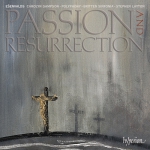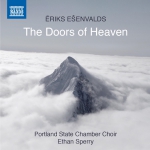Passion and Resurrection was written in 2005 and premiered by Māris Sirmais and the State Choir Latvija. Eschewing the single narrative perspective that characterizes the great Passion settings of the past, the composer has assembled an interlocking mosaic of texts from the gospels, from Byzantine and Roman liturgies, and from the Old Testament. The result (though given a seamless continuity by the music) is fragmentary — a series of snapshots, the tale told elliptically (if directly), combining action and reflection in equal measure; linear chronology is not always strictly observed, and the story begins with a fallen woman acknowledging the divinity of Jesus, and ends with Mary Magdalene (who may be that same fallen woman) recognizing the risen Christ. This circularity (and there are similar echoes and pre-echoes within the narrative) serves to emphasize that these are not historical events but are occurring in an eternal present, just as the passion and resurrection of Christ are re-enacted and re-experienced by Christians every week.
There are no designated characters in the piece: the chorus voices the words of Jesus and reports on events. The prominent solo soprano is a distinctively Marian and maternal presence, as the woman who anoints Christ’s feet, as the visionary Mary Magdalene, and as a tenderly sympathetic observer of Jesus and his mother’s suffering. The string ensemble by turns amplifies the choral textures, offers a static underpinning with sustained drones, and subtly undercuts the vocal message with ironic counterpoints of its own.
The work is in four parts, each prefaced by lines from scripture, which play without a break. Part I opens with four solo voices singing a setting of Parce mihi by the sixteenth-century Spaniard Cristóbal de Morales; seemingly preludial, this objet trouvé is soon established as an important other-worldly presence as gently dissonant string chords are laid over it, and the solo quartet returns subsequently with Morales-derived material, always a hauntingly alien feature in the musical landscape. The soprano recitative that follows is both lamenting and ecstatic, supported by long-drawn string textures which reveal the distinctive harmonic tincture of the work — fluidly modal, flecked with chromaticism, and inclined to downwards semitonal step-movement in the bass. The choral benediction that ends this section has a beatific calm, though as it dissolves into whispers uncertainty returns with an uneasily transparent string chorale.
Part II begins with open-fifth drones in the lower instruments, anchoring the restless lament of the choir in a static D minor, sardonic violin figures offering their own dissident commentary. As the drama intensifies, the sense of foreboding increases, with downward harmonic shifts and greater chromatic density. There is a pounding muscularity to this account of Jesus’s humiliation which culminates in hammered shouts of ‘crucify’, haloed by a shrieking string texture ‘imitating extremely nervous clamours of seagulls’ (the composer instructs). After a fortissimo call for forgiveness, ‘they know not what they do’, subject to multiple repetitions, the solo quartet returns, their tonal certainties anointed with healing balm from the soprano, though as the chorus murmurs a Latin version of the quartet’s words, instability returns as the strings tell a different harmonic story.
Part III has a simple rondo structure. Over an ‘eternal’ pedal C, the soloist offers up an extended meditation, ambiguous in modality and embellished with grace notes and glissandi, while a single violin provides an agitated, flickering descant. Twice the soloist is answered by the choir with luminous diatonic clarity, as two lone sopranos soar to seraphic heights; the second time around this blissful resignation erupts into anguished cries and the final grieving is shared by the soloist and the choir, the strings adding to the desolation with subtle enrichments of the voicing. Again, the solo quartet has the last word, as Jesus gives up his spirit.
The melismatic, rapturous unaccompanied solo that opens Part IV is echoed by hushed choral chanting, cushioned by strings. The landscape is bare, as sighing pairs of chords haltingly descend over an inner pedal. The dazzling moment when ‘the Lord is risen’ is exultant and brief; there is a hiatus of uncertainty before the act of recognition that is the crux of the matter is heralded by the solo quartet. Their rapt repetitions of ‘Mariam’ draw in the choir, hesitant at first yet ultimately glowing as they settle into a gentle oscillation of two chords; the voice of Mary Magdalene soars above them with quiet radiance. Over and over again they call to each other, hypnotic and serene, as a luminescent string chorale slowly ascends to the heights. Yet there is an ambiguity at the very end — which of the two chords is perceived as the ‘tonic’? This lack of finality is essential, for the story must, and will, begin again.
— from notes by Gabriel Jackson © 2011




